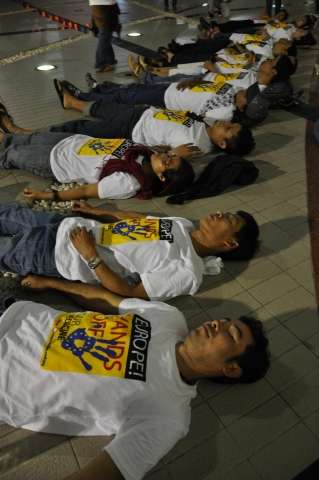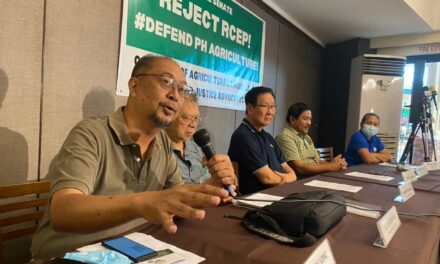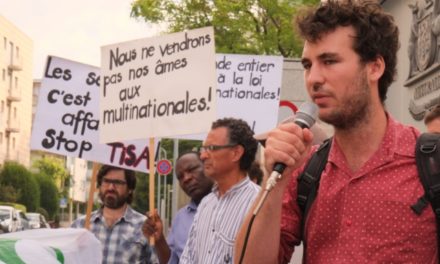by Joseph Purugganan
Just when everyone thought that the free trade agenda had gone totally moribund, latest developments in international trade negotiations have given it a shot in the arm, reviving efforts to further liberalize markets for goods and services, secure protection for intellectual property and guarantee investor rights. So called new generation free trade agreements (FTA)—broad, comprehensive and highly ambitious trade and investment deals—are dotting the global landscape and the long-stalled talks in the World Trade Organization (WTO) have also gotten a boost with the proposals for an ‘early harvest’ package expected to be delivered at a ministerial conference later this year in Bali.
The announcement last February of the launch of negotiations for a US-EU free trade agreement, also called the Trans-Atlantic Trade and Investment Partnership Agreement and now touted as the biggest trade deal in history, signalled an intensification of a de facto turf war among trade super powers the United States, the European Union and China, all aggressively pushing their geo- economic agenda within their respective regional platforms or networks of free trade agreements.
For the US and EU, this move was clearly an effort to enhance their competitiveness and revive their crisis-laden economies. European Commission President Jose Manuel Barroso called the future deal between the world’s two most important economic powers “a game-changer” in his remarks following US President Barack Obama’s announcement of the talks in his State of the Union Address.
Reflecting on US trade and investment policy under his second term in office, Obama spelled out the motivation of the US for launching trade talks with the EU as well as for completing negotiations on a Trans-Pacific Partnership Agreement (TPPA), and that is to “boost American exports, support American jobs and level the playing field in the growing markets of Asia.”[1]
These deals and a wave of similar highly ambitious free trade and investment agreements being pursued by the EU across Asia reflect a shared desire by both the US and the EU to “set the standard—not only for our future bilateral trade and investment, including regulatory issues, but also for the development of global trade rules.”[2]
FTA landscape
The US Standard
The TPP is a free trade agreement being negotiated by nine countries in the Asia Pacific Region : Singapore, Brunei, Malaysia and Vietnam from ASEAN, Australia and New Zealand from the Pacific, Chile and Peru from Latin America, and the United States from North America. Largely regarded as a US led initiative, the agenda of the TPP talks revolve around five defining features which according to the US Trade Representative Office (USTR) would make TPP a “landmark, 21st-Century trade agreement.”[3] The key elements are: Comprehensive Market Access; fully regional agreement to facilitate the development of production and supply chains; cross-cutting issues of regulatory coherence, competitiveness and business facilitation, small and medium enterprises, and development; and addressing new trade challenges related to the digital economy and green technologies.
The fifth defining feature of the TPP and one that really stands out as a major innovation in the approach to trade negotiations is the idea of the living agreement, which will enable the updating of the agreement to address future issues as well as the expansion of the membership to accommodate new entrants.
The TPP talks cover a whole set of issues from the more traditional market access issues in goods and services, rules of origin and technical barriers to trade, to the so called Singapore issues of trade facilitation, competition policy, government procurement and investments. The main principle guiding these negotiations is the adherence to the strict requirements of high standards in all these areas.
The16th round of the negotiations recently concluded in Singapore where the reports have been of “solid progress in a number of key areas like regulatory coherence, customs and development.”[4] Sticking points however remain in the more contentious areas of intellectual property, the environment, competition and labor policies.”[5] Another major development around the TPP talks has been the announcement recently of Japan’s intention to join the talks, a move that sparked opposition from within Japan as well as from outside including US politicians who have been highly critical of Japan’s trade restrictions on auto exports from the States.[6]
Asia has become the main driver of global economic growth. To a large extent these developments in the FTA front are also motivated one way or another by the desire to get a slice of the action in Asia. There has been a lot of talk about Obama’s “Asian pivot’, the shift in US foreign policy aimed at refocusing on Asia, and the underlying motive of counterbalancing China’s growing power and influence in the region. On the economic front, the Asian pivot is evident in the efforts of the US and Japan to come to an agreement over the latter’s entry in to the TPP. The EU is likewise adopting strategies targeting China. A recent report called the EU’s strategy to “boost exports to China a ‘Jekyll and Hyde’ trade policy, blending diplomatic overtures with tough legal action against dumping and protectionism.”[7]
Competitiveness Driven FTAs
Not to be left behind, the European Union has likewise pursued the bilateral free trade track quite aggressively over the last five years with its own brand of what it calls competitiveness-driven FTAs. In 2007 it launched simultaneous FTA negotiations in Asia with Korea, India and the ASEAN regional bloc. The deal with Korea came into force in 2011, representing EU’s first new generation FTA in Asia. The negotiations with India are continuing and optimistic assessments point to contours of a deal emerging.[8]
The negotiations with ASEAN shifted gears in 2010 when the EU adopted a more aggressive bilateral approach, setting aside for the time being the region to region approach to the talks. Under the bilateral approach, a deal has been forged with Singapore in late 2012; negotiations are continuing rapidly with Malaysia, and new talks have been launched with Vietnam (2012) and more recently with Thailand (2013). Negotiations are also expected to be launched this year with the Philippines and Indonesia.
Asian consolidation
Asian countries on the other hand are developing their own platforms even as they engage in negotiations with both the US and EU. Under the banner of East Asian economic cooperation, ASEAN has spearheaded together with six other nations with which the group has FTAs, namely China, India, Korea, Japan, Australia and New Zealand. A comprehensive agreement is also being pursued to consolidate the Regional Comprehensive Economic Partnership (RCEP), which has been described as “the largest free trade bloc in the world.[9] While the RCEP aims for progressive elimination of tariffs and non-tariff barriers, the underlying principle of the agreement is more to harmonize the existing FTAs and to make them consistent with WTO rules. Compared to TPP, the RCEP makes fewer demands for economic change.[10]
Another development in Asia is the launch in late 2012 of trilateral talks among China, Japan and Korea, the three biggest economies in the region. The first working-level meeting to hammer out a deal is expected to begin in late March in Seoul.[11]
The move to consolidate a “fully regional economic partnership” via RCEP and negotiations for the China-Korea-Japan FTA is Asia’s response to the changing global trade dynamics.
Post Crisis twists and turns
Contrary to expectations that the economic crisis will somehow slow down FTA activity as demand declines, trade contracts and countries adopt a more cautious and inward-looking economic policies, what we have seen instead is a more aggressive push to launch and conclude FTAs since the global economic crisis. The motivations of the major players remain largely the same but have become more upfront and more political. The deals are meant to protect their competitiveness, secure jobs at home, secure much needed raw materials to fuel their own industries, push for greater market access for their goods and services, open up investments and protect the interest of corporations. But these agreements are equally about reforming national policies to conform to the new standards, which are viewed by some analysts as going way beyond the traditional parameters of trade agreements. A report in the Guardian newspaper referred to the TPP for example as “an effort to use the holy grail of free trade to impose conditions and override domestic laws.”[12]
In at least two main areas—the chapters on investment and intellectual property rights—the level of ambition being reached through these new generation FTA, demands from developing countries commitments beyond their obligations under the WTO (WTO plus) and will mean a major erosion of domestic policy space.
The standard investment being pushed under both the US and EU led negotiations will allow higher level of investor protection including the controversial investor to state dispute settlement mechanism (ISDS).
The chapter on intellectual property rights is another contentious and ambitious area being pushed through the FTA talks. Consistent with their long-held position on the protection of intellectual property, the US and EU- have proposed FTAs that demand commitments beyond those made under the WTO agreement on intellectual property (WTO-TRIPS). Under this kind of FTA, the IPR chapter with TRIP-plus provisions will effectively curtail the production of generic medicines, which are crucial to many patients across the developing world seeking more affordable medicines and treatment for their life threatening diseases.
‘Like-minded’ Approach
These new generation FTAs are likewise changing the process and approach to trade and investment negotiations. The US-led TPP talks have put in place a ‘like-minded’ approach to negotiating FTAs. In this approach, talks begin at high standards of liberalization. The nine countries that initiated the talks more or less were on the same footing on a number of important principles and concrete issues. Adopting the principle of ‘living agreement’, countries along the way can opt to join the talks under a set of pre-conditions mainly to prove adherence to the high liberalization standards. This ‘like-minded’ approach therefore is not really something new but is cut from the same classic ‘bandwagon’ cloth. It continues to work as more and more countries express interest to be part of the TPP talks out of fear of being left out and left behind. In Southeast Asia, two more countries, the Philippines and Thailand, have expressed serious intentions to join the TPP. The Philippines for example recently announced a ‘road map’ for joining the talks.[13]
A similar approach has been adopted under RCEP with its open accession scheme that will allow other members to join as long as they agree to comply with the grouping’s rules and guidelines.
The Road to Bali
The 9th Ministerial Meeting of the World Trade Organization (WTO) has been scheduled for first week of December 2013 in Bali, Indonesia. The Bali Ministerial is envisioned yet again to provide the spark to re-energize the otherwise moribund multilateral trade talks and safeguard the legitimacy of the WTO as the pillar of the multilateral trading system. The negotiations leading up to Bali now revolve around a set of proposals to be included in an ‘early harvest’ package expected to be delivered at the high level conference. While there seems to be a high level of consensus among governments around the need to deliver something in Bali, there are divergent views on whether the Bali outcome would serve as stepping stones for the eventual conclusion or a final nail in the coffin of the Doha round.
The US position is quite clear. As spelled out in the 2013 articulation of its trade, the US sees the need to make the WTO “an institution for the 21st Century”. While the US still views the WTO as the primary forum for “liberalizing multilateral trade, developing and enforcing global trade rules, and serving as a bulwark against protectionism,” it is interesting that the WTO agenda only comes fourth in the order of strategies towards its over-all goal of expanding job-supporting US trade; trailing behind the National Export Initiative (NEI); advancing the conclusion of an ambitious Trans-Pacific Partnership Agreement (TPPA); and the recently announced Trans-Altantic Trade and Investment Partnership with the European Union.[14]
The US position in the lead up to Bali is anchored on advancing “market-opening measures along avenues with the highest potential to yield significant and timely results.” It has given explicit support for a trade facilitation agreement that would “remove trade barriers to realize significant development gains.” The notion of development is expressed in some vague commitment to explore agreements on development issues, and in terms of providing resources for LDC’s full participation in the WTO.
The US is also pushing for the launch this year of multi-party negotiations among like-minded WTO Members towards an ambitious international services trade agreement (ISA).
The US is likewise pushing for a new multilateral architecture. It is interesting to note that there ishardly any reference to Doha in the US 2013 trade policy document, except to highlight the impasse in the talks, and the policy seems to indicate a direction towards “moving negotiations along more constructive and productive pathways.” [15]
This hints of a position to do away with the Doha mandate altogether and push for a new negotiations architecture anchored on the following elements: Multi-party negotiations within multilateral frame; the consolidation of like-minded groups on key negotiating issues; and high standards (market access, IPR, services liberalization, investments) reflecting and in the future ‘multilateralizing’ or bringing the high standards of commitments in the ambitious and comprehensive bilateral and trans-continental FTAs into the multilateral arena.
Resistance Continues
People’s resistance to FTAs continues to re-energize and consolidate across the globe through various national, regional and global platforms. New constituencies have emerged around key issues of health and access to medicines and farmers rights. In India, and across much of Southeast Asia, patients’ networks led by people living with HIV-AIDS, are at the forefront of campaigns against these ambitious agreements. Together with trade advocacy groups and networks, the health advocates have gone to the streets to protest provisions that will undermine people’s access to medicines. They have filed various petitions to governments and to national and regional human rights institutions highlighting the threats posed by these agreements on the right to health.
In the run up to Bali, Indonesian groups have re-energized Gerak Lawan, the Indonesian People’s Movement Against Neocolonialism-Imperialism to spearhead national and international mobilizations against neoliberalism and to demand economic justice.
“People and nature have endured enough abuse” according to the call issued by Gerak Lawan. They add that “We should declare the WTO as illegitimate, call for revocation of all FTAs and demand that governments not sign new ones, and formulate an alternative model of trade based on economic justice.”[16]
[1] Full text of US President Barack Obama’s State of the Union Address. 13 February 2013. http://www.bbc.co.uk/news/world-us-canada-21437788
[2] The US-EU Trade Deal: Foundation for a New Global Economic Order by Dana Gabriel. Global Research. Last accessed 18 March 2013. http://www.globalresearch.ca/the-u-s-eu-free-trade-deal-foundation-for-a-new-global-economic-order/5324509
[3]Outlines of the transpacific partnership agreement. USTR website. Last accessed 18 March 2013. http://www.ustr.gov/about-us/press-office/fact-sheets/2011/november/outlines-trans-pacific-partnership-agreement
[4] 16th Round of TPP talks end with solid progress. MY Sinchew.com. last accessed 18 March 2013.http://www.mysinchew.com/node/84037?tid=37
[5] TPP members finish 16th round of negotiations report by M. Singh of Business Times Singapore. Last accessed 18 March 2013. http://www.businesstimes.com.sg/premium/singapore/tpp-members-finish-16th-round-negotiations-20130314
[6] Various Congressional Democrats Oppose Japan’s TPP bid. Report by z. Keck for The Diplomat. Last accessed March 18, 2013. http://thediplomat.com/pacific-money/2013/03/18/various-congressional-democrats-oppose-japans-tpp-bid/
[7] EU gains from “Jekyll and Hyde” trade tactics with China – study. Report by T. Miles. Reuters. 18 March 2013.
http://uk.reuters.com/article/2013/03/18/uk-eu-china-trade-study-idUKBRE92H0LZ20130318
[8] The EU’s Free Trade Agreements-Where are We? European Commission Memo. 18 February 2013. Last accessed 18 March 2013. http://europa.eu/rapid/press-release_MEMO-13-113_en.htm
[9] Asean and Partners Launch Regional Comprehensive Partnership. Report by M. Hiebert and L. Hanlon. Center for Strategic and International Studies website. Last accessed 18 March 2013. http://csis.org/publication/asean-and-partners-launch-regional-comprehensive-economic-partnership
[10] Asean and Partners Launch Regional Comprehensive Partnership. Report by M. Hiebert and L. Hanlon. Center for Strategic and International Studies website. Last accessed 18 March 2013. http://csis.org/publication/asean-and-partners-launch-regional-comprehensive-economic-partnership
[11]Insight: Hopeful China wants Japan, S. Korea in own trade pact. Report from Asahi Shimbun. 18 March 2013. Last accessed 18 March 2013. http://ajw.asahi.com/article/behind_news/politics/AJ201303180007
[12] The Pacific free trade deal that’s anything but free by Dean Baker of the Guardian. http://www.guardian.co.uk/commentisfree/2012/aug/27/pacific-free-trade-deal
[13] PH eager to join transpacific pact. Report by Rappler. 18 March 2013. Last accessed 18 March 2013. http://www.rappler.com/business/economy-watch/24088-ph-trans-pacific-trade-pact
[14] US Trade Policy Agenda 2013 under President Barack Obama. http://www.ustr.gov/sites/default/files/AnnualReport%20Final2013.pdf
[15] US Trade Policy Agenda 2013 under President Barack Obama. http://www.ustr.gov/sites/default/files/AnnualReport%20Final2013.pdf
[16] Deal a decisive blow to Neoliberalism End the WTO and the Stop the new wave of Free Trade Agreements The time is now for Economic Justice! Call to Action issued by Gerak Lawan. 16 March 2013.
Photo by FTA Watch










